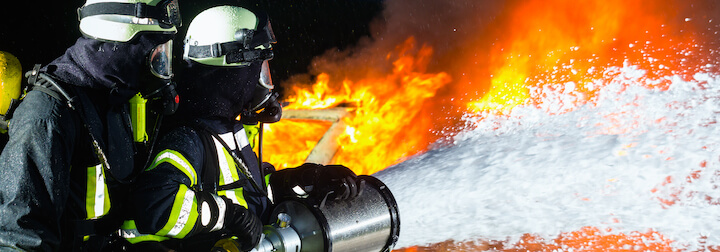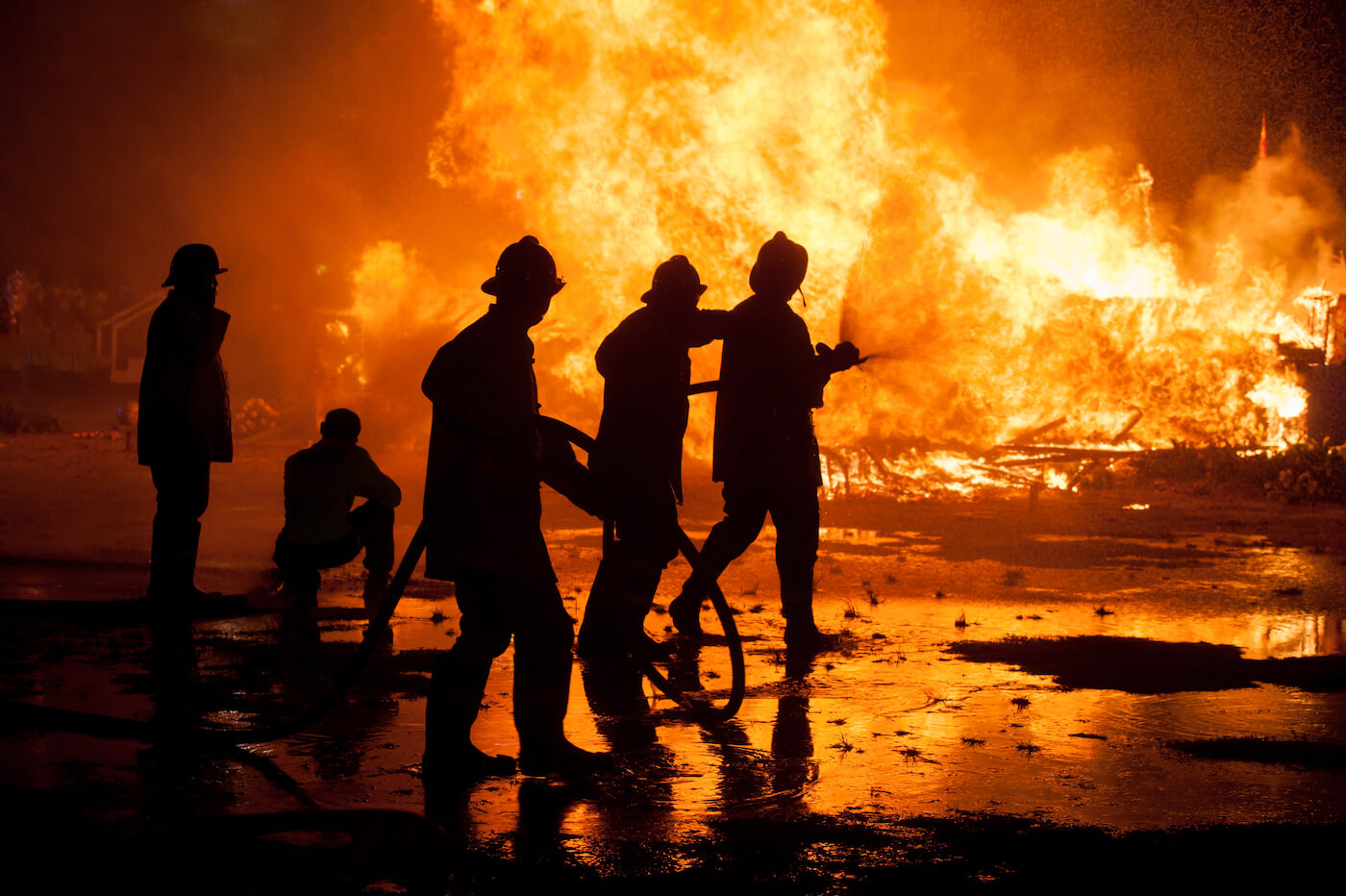What does AFFF stand for?
AFFF stands for aqueous film-forming foam. It’s often referred to simply as firefighting foam.
What chemicals are in firefighting foam?
Aqueous film-forming foam, or AFFF, has been manufactured with perfluoroalkyl and polyfluoroalkyl substances (PFAS) since the 1950s. Two particular PFAS compounds found within the foam are perfluorooctanoic acid (PFOA) and perfluorooctanesulfonic acid (PFOS). These synthetic chemicals work to suppress flammable-liquid fires by creating a barrier between the fuel and the oxygen it needs to burn.
Both PFOA and PFOS have been identified by the EPA as “emerging contaminants.” That means they’re suspected of causing negative health effects in humans. Additionally, these chemicals are “persistent,” so they don’t break down after entering the body or the environment. When firefighting foam is used, PFOA and PFOS spread throughout nearby soil, often contaminating local drinking water sources. Once ingested, the potentially toxic AFFF PFAS will remain in your system and continue to “bioaccumulate” upon further exposure.
AFFF Foam Cancer Threats & Other Health Effects

PFAS are AFFF foam hazards and can enter the body through inhalation, oral ingestion, or absorption through the skin. No matter how you come in contact with the firefighting foam, the health effects that result from prolonged exposure can be severe. They may even be life-threatening.
The Environmental Working Group (EWG) and Centers for Disease Control and Prevention (CDC) both warn that exposure to firefighting foam or water contaminated with PFAS can increase the risk of cancer. Because those chemicals are in AFFF, that means there’s evidence of a link between firefighting foam and cancer. What’s more, since the armed services use AFFF, military bases are linked to cancer as well.
Beyond an increased risk of cancer, communities that suffer from prolonged exposure to the chemicals in firefighting foam may have higher rates of various other diseases, disorders, and health problems. These health issues are considered AFFF exposure symptoms since they can help identify AFFF contamination in a certain area. Possible AFFF exposure symptoms include:
- Increased risk of cancer
- Damage to the immune system
- Birth defects
- Fertility issues
- Thyroid disease
- Liver damage
- Asthma
- Increased cholesterol
Toxic chemicals have been linked to several types of AFFF foam cancer, such as:
- Kidney cancer
- Testicular cancer
- Ovarian cancer
- Bladder cancer
- Liver cancer
- Breast cancer
- Pancreatic cancer
- Leukemia
- Lymphoma
Working with McIntyre Law
Victims who are suffering from firefighter foam health effects deserve to be compensated. But the complex legal process can be intimidating. Still, the high costs of medical treatment and missed wages shouldn’t fall on your shoulders.
Someone needs to hold the manufacturers who put PFAS in firefighting foam accountable for their negligence. The product liability attorneys at McIntyre Law can use their decades of experience to defend your rights and help you build a winning AFFF foam lawsuit.
Do you have a case for an AFFF lawsuit?
Filing an AFFF foam lawsuit may be the only way to get fair compensation for your pain and suffering. Since the PFAS in firefighting foam don’t break down in the environment, you may have been affected even if you didn’t have direct contact with AFFF. In fact, over 2,000 locations in 49 states are known to have PFAS contamination. That’s why it’s important to know the symptoms of AFFF exposure and understand which groups of people are at the highest risk of illness.
You may have a case for an AFFF foam lawsuit if you developed cancer after:
- Serving as an airport or military firefighter who used AFFF
- Working in an environment that handles or produces AFFF or PFAS
- Working on a military base with PFAS-contaminated water
- Living near military bases, airports or industrial sites where AFFF was used
If you’re unsure whether you qualify for a lawsuit, you can contact us anytime for a free consultation. We’ll review your case and do everything in our power to get you compensated for your injuries.
Is there currently an AFFF class-action lawsuit?
In February 2020, an AFFF class-action lawsuit was filed against the companies who make firefighting foam. The victims claim that the manufacturers chose to make and sell AFFF despite being aware of the various health and environmental hazards associated with PFAS chemicals. Now, those affected are seeking compensation for their medical expenses and attorney fees, as well as a court-supervised water testing program.
How is an AFFF class-action lawsuit different from an individual case?
Unlike individual cases, class-action lawsuits are brought on by one or more people on behalf of a larger group of plaintiffs who have suffered similar damages or have similar claims. If a settlement or award is won through the lawsuit, it gets divided among all plaintiffs represented in the case.
Victims can be represented in a class-action lawsuit regardless of where they live. The same thing goes for McIntyre Law. Even though we’re based in Oklahoma, our firm operates with a nationwide reach. That means you’ll have access to the best AFFF lawyers no matter where you’re located. Our team of firefighting foam attorneys prides itself on delivering personalized, small-town service that gets our clients big results. And any time you have a question or concern, our firm’s senior partner and founder, Noble McIntyre, is just a phone call away.
What to Know Before You File a Lawsuit
Filing a lawsuit can be a complicated process, often requiring thorough legal preparation and knowledge of the court system. In the case of a product liability lawsuit, the burden of proof falls on the plaintiff. This means that in order to prove your case, you’ll need to show the courts that:
- You were injured or suffered damages.
- The product was defective or lacked proper warnings.
- The defect or lack of warning was the cause of your damages.
- You were using the product correctly.
This process generally requires you to collect medical records that provide information about your healthcare appointments and medical history. Depending on which state you live in, the amount of time your healthcare provider holds your records will vary, so it’s best to check their availability as soon as possible.
If you were in the armed services, you’ll likely be required to obtain your military medical records as well. Beyond gathering medical records, you’ll need to file various court documents, such as a complaint or petition. This will summarize your case for the court and serve as a summons to the defendant(s).
It’s possible to handle this process on your own. But things can quickly become stressful and overwhelming for someone who isn’t familiar with the law. That’s why enlisting the help of an established AFFF lawyer is so important. Cases like these have high stakes and no room for error. The dedicated firefighting foam attorneys at McIntyre Law can level the legal playing field and fight to get you the compensation you deserve.
What is a contingency fee?
Lawyers who work on a contingency fee basis receive a fixed percentage of any monetary rewards that result from your lawsuit to cover their legal fees. That means if there’s no money recovered from your AFFF foam lawsuit, you don’t owe us a dime. We only get paid once you do.
The Oklahoma Statute of Limitations for AFFF Lawsuits
A statute of limitations determines the amount of time you have to take legal action after you discover your injuries. The length of time will vary depending on the type of case you have and the state you live in. For a product liability case, such as an AFFF foam lawsuit, the Oklahoma courts give you two years from when you first notice symptoms to file your claim.
Compensation for AFFF-related loss or suffering
Dealing with firefighting foam health effects can be costly, but by filing a lawsuit, you could collect compensation for your damages. Veterans who were harmed by military groundwater contamination or have served on a military base linked to cancer can also file an additional claim for disability compensation for their health issues.
Upon winning your AFFF foam lawsuit, you’ll be eligible to receive compensation for:
- Medical bills
- Pain and suffering
- Lost wages
- Future expenses
- Mental anguish
- Other out-of-pocket costs
If a loved one lost their life due to a form of AFFF foam cancer or other related health complication, you may be able to seek compensation for losses such as funeral costs through a wrongful death lawsuit.
Meet Our AFFF Foam Attorneys
At McIntyre Law, we stand by firefighters and service members who’ve been harmed by AFFF foam hazards. Our expert legal team has over 90 years of experience litigating cases for the wrongfully injured. We’ll use our knowledge and resources to hold the manufacturers of AFFF accountable and win you compensation for your suffering.
Why are military bases linked with cancer?
Despite knowing about potential AFFF foam hazards, the Department of Defense has been overseeing the use of PFAS-containing firefighting foam across military bases since the 1970s. Exposure to AFFF through consistent usage and contaminated water sources has led many service members and civilians to develop health problems, such as various types of cancer. It wasn’t until 2018 that the Air Force became the first military branch to transition to a safer, fluoride-free alternative to AFFF. The Army and Navy have since followed suit, aiming to complete their AFFF phaseouts by 2020.
Meanwhile, the Department of Defense has begun working with the CDC to identify contaminated bases and communities and implement safety changes, such as installing water filters and providing stocks of bottled water. As of 2019, they had marked 206 military sites as having PFAS-contaminated groundwater, in addition to 664 current or former military training sites. Affected sites in Oklahoma include:
- Altus Air Force Base
- Vance Air Force Base
- Tinker Air Force Base
- Will Rogers World Airport
- Tulsa International Airport
Here’s a more comprehensive list of military bases with contaminated water, courtesy of the Environmental Working Group.






